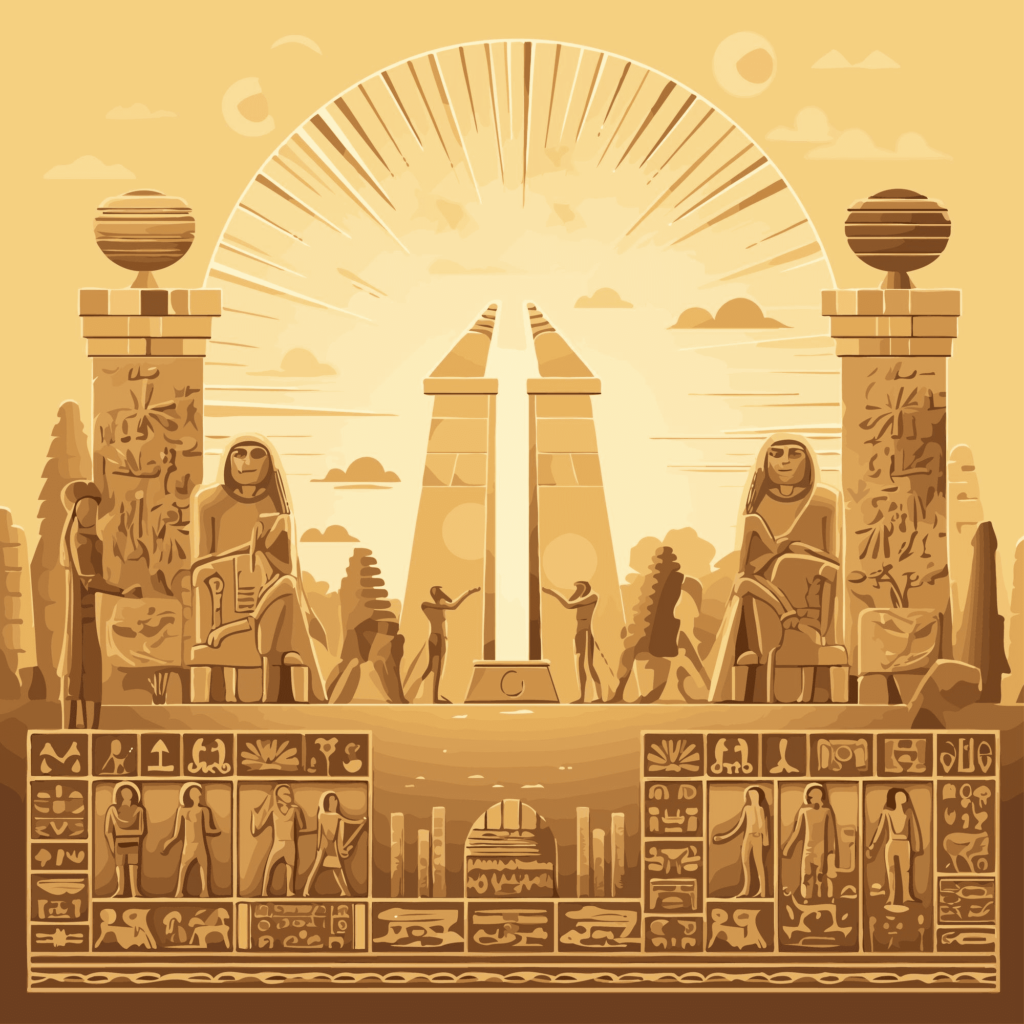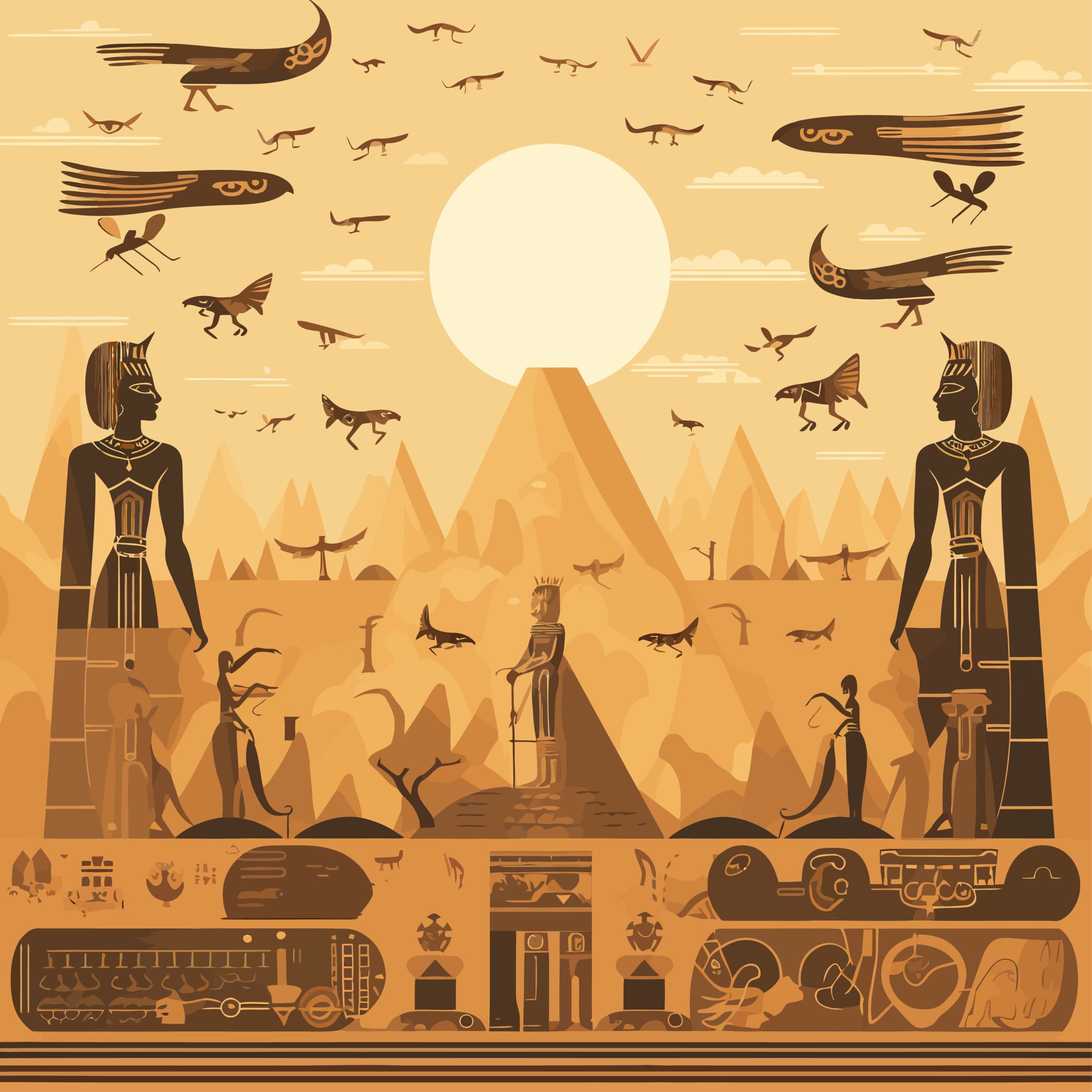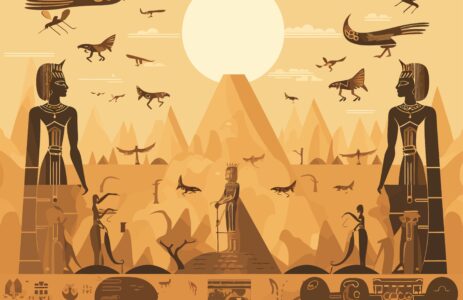Ancient Egypt and Mesopotamia are often called the “cradles of civilization,” emerging around the same time (circa 3000 BCE) along the banks of mighty rivers—the Nile in Egypt and the Tigris-Euphrates in Mesopotamia. These two societies laid the foundations for urban life, writing, law, and monumental architecture, yet they developed in strikingly different ways. While Egypt became synonymous with stability, enduring for nearly 3,000 years with relatively few disruptions, Mesopotamia was a land of constant upheaval, where city-states rose and fell in rapid succession. What caused such a dramatic contrast? The answer lies not just in human ingenuity but in the very landscapes these civilizations called home.
Geography played a decisive role in shaping their destinies. The Nile’s predictable floods gifted Egypt with agricultural abundance and natural protection, fostering a culture of order and permanence. Meanwhile, Mesopotamia’s unpredictable rivers and open plains demanded innovation in irrigation but also left it vulnerable to invasions and environmental crises. By examining how these two civilizations adapted to their environments, we uncover a fundamental truth of history: the land does not just provide resources—it shapes empires, cultures, and even gods. This comparison will explore how geography made one civilization a fortress and the other a battleground.
The Role of Rivers: Nile vs. Tigris & Euphrates
The Predictable Nile vs. Unpredictable Mesopotamian Rivers
The Nile and the Tigris-Euphrates were the lifeblood of their civilizations—but their behaviors couldn’t have been more different.
- Egypt’s Nile: The Gift of Consistency
- Flooded annually like clockwork, depositing rich, fertile silt that turned the Nile Valley into a breadbasket.
- Egyptians called their land Kemet (“Black Land”) for the dark soil left by floods, contrasting with the Deshret (“Red Land”) of the surrounding desert.
- This reliability allowed Egyptians to develop a stable agricultural calendar, with little need for complex irrigation—just simple basin farming.
- Mesopotamia’s Tigris & Euphrates: Chaos and Control
- Floods were violent and unpredictable, arriving at different times each year, sometimes too weak (leading to droughts) or too strong (washing away crops).
- Required advanced irrigation systems—canals, dikes, and reservoirs—to manage water distribution.
- This need for coordination may have spurred early centralized governance (like the Sumerian city-states).
Impact on Agriculture and Food Supply
The rivers didn’t just shape farming—they shaped entire societies.
- Egypt: Surplus and Stability
- The Nile’s consistency meant reliable harvests, leading to food surpluses that supported a strong centralized government (the pharaoh’s bureaucracy).
- Grain storage (like in Joseph’s biblical story) was more about long-term planning than survival.
- Mesopotamia: Scarcity and Struggle
- Erratic floods and soil salinization (from over-irrigation) reduced crop yields over time.
- Food shortages forced trade networks with Anatolia (for metals) and the Indus Valley (for timber).
- The world’s first recorded famine (Ur III period) shows how precarious life was.
Flood Myths & Religious Responses
Even their gods reflected their rivers’ natures.
- Egypt: Ma’at and the Order of the Nile
- The goddess Ma’at symbolized cosmic harmony—just as the Nile’s floods brought balance.
- Pharaohs were seen as divine maintainers of order, ensuring the Nile’s blessings.
- Mesopotamia: Gods of Chaos and Punishment
- The Epic of Gilgamesh describes a flood sent by angry gods to wipe out humanity.
- Gods like Enlil were feared—their myths reflected the unpredictable terror of Mesopotamian floods.
Natural Barriers: Protection vs. Vulnerability
Egypt’s Natural Fortress
Egypt was geographically blessed with defenses:
- Deserts as Walls: The Sahara to the west and Eastern Desert blocked invaders.
- Seas as Moats: The Mediterranean and Red Sea limited naval attacks.
- Only Two Entry Points: The Sinai Peninsula (east) and Nubia (south) were the main invasion routes—both heavily guarded.
Result: Fewer invasions → 3,000 years of cultural continuity (only major disruptions: Hyksos, Sea Peoples, and later Persians).
Mesopotamia’s Open Land = Constant Conflict
Mesopotamia had no natural defenses:
- Flat Alluvial Plains: Perfect for farming—but also easy marching for armies.
- Revolving Door of Empires:
- Akkadians (first empire under Sargon)
- Babylonians (Hammurabi’s laws)
- Assyrians (brutal warfare)
- Persians (final conquerors)
- Warfare as Culture: The Epic of Gilgamesh glorifies battle, and gods like Ishtar were linked to war.
Result: A cycle of rise, conquest, and collapse—yet also innovation (writing, law codes, siege warfare).

Resource Availability & Trade Networks
Egypt’s Self-Sufficiency: The Gift of the Nile
Egypt was a land of abundance, thanks to the Nile’s generosity:
- Food Security: The Nile’s predictable floods ensured bountiful harvests of wheat, barley, and flax (for linen).
- Building Materials:
- Limestone & granite from quarries built the pyramids and temples.
- Papyrus (from Nile marshes) became the world’s first paper.
- Precious Resources:
- Gold from Nubia (south) made Egypt wealthy—pharaohs called it “the flesh of the gods.”
- Copper from Sinai fueled tools and weapons.
Limited Early Trade:
- Egypt initially had little need for imports—its isolation (deserts, seas) meant it traded mostly for luxuries (Lebanese cedar for shipbuilding, incense from Punt).
- Unlike Mesopotamia, Egypt avoided economic dependency—its wealth came from within.
Mesopotamia’s Dependence on Imports: The Price of Progress
Mesopotamia lacked basic raw materials, forcing it to become a trade powerhouse:
- Critical Shortages:
- No stone → mud-brick ziggurats (unlike Egypt’s pyramids).
- No metals → imported copper, tin (for bronze) from Anatolia and Iran.
- No timber → traded with Lebanon for cedar.
- Trade Networks:
- Indus Valley (modern Pakistan): Lapis lazuli, ivory.
- Anatolia (Turkey): Silver, obsidian.
- Persian Gulf: Pearls, fish.
Cuneiform: The Birth of Accounting
- Trade deals were so complex that Mesopotamians invented writing (cuneiform) to track transactions.
- The world’s first recorded contracts and business receipts appeared here.
How Trade Shaped Their Economies
- Egypt: Barter System
- Grain, linen, and gold were exchanged directly—no standardized currency.
- The government controlled trade, limiting private markets.
- Mesopotamia: Early Capitalism
- Traders used silver shekels as a proto-currency.
- Private merchants flourished, leading to loan systems and interest rates (as high as 20%!).
Legacy: How Geography Influenced Their Downfall
Egypt’s Gradual Decline: A Fortress Finally Breached
Egypt’s geography delayed its collapse, but couldn’t prevent it forever:
- Natural Barriers Weakened:
- The Hyksos invasion (1650 BCE) proved Egypt wasn’t invincible.
- Later, Sea Peoples, Assyrians, and Persians chipped away at its power.
- Environmental Stress:
- Droughts during the New Kingdom led to famines and civil unrest.
- The Nile’s flood patterns shifted, reducing agricultural output.
- Final Blow: Rome annexed Egypt in 30 BCE after Cleopatra’s fall.
Why It Lasted So Long:
- 3,000 years of continuity—thanks to natural defenses and the Nile’s reliability.
Mesopotamia’s Cycle of Rise & Fall: The Cost of Open Lands
Mesopotamia’s lack of barriers made it history’s revolving door:
- Conquest After Conquest:
- Akkadians (2334 BCE) → Babylonians (1792 BCE) → Assyrians (911 BCE) → Persians (539 BCE).
- Each new empire rewrote laws, gods, and culture.
- Environmental Collapse:
- Soil salinization from over-irrigation turned fields barren.
- Deforestation (from overusing timber) worsened floods.
Paradox of Progress:
- Mesopotamia invented writing, math, and law—but its instability prevented long-term unity.
Which Civilization Was More Resilient
| Egypt | Mesopotamia |
|---|---|
| Lasted longer (3,000+ years) | More innovative (writing, wheel, astronomy) |
| Stable but conservative | Dynamic but chaotic |
| Fell due to external forces | Collapsed from within (erosion, wars) |
Final Verdict:
- Egypt survived better, but Mesopotamia changed the world more.

Conclusion
The contrasting fates of ancient Egypt and Mesopotamia reveal a profound truth of history: geography is destiny. Egypt’s sheltered Nile Valley, with its predictable floods and natural defenses, fostered three millennia of stability, allowing its culture, religion, and political systems to flourish with remarkable continuity. Meanwhile, Mesopotamia’s open plains and volatile rivers made it a crucible of innovation—giving birth to writing, codified laws, and long-distance trade—but also left it vulnerable to relentless invasions and environmental decay. While Egypt endured as a unified civilization far longer, Mesopotamia’s fragmented dynamism ultimately spread its revolutionary ideas across the ancient world. Their legacies remind us that landscape doesn’t just shape survival—it determines whether a society becomes a fortress or a crossroads, a preserver of tradition or an engine of change. In the end, both approaches laid the foundations of civilization as we know it.


